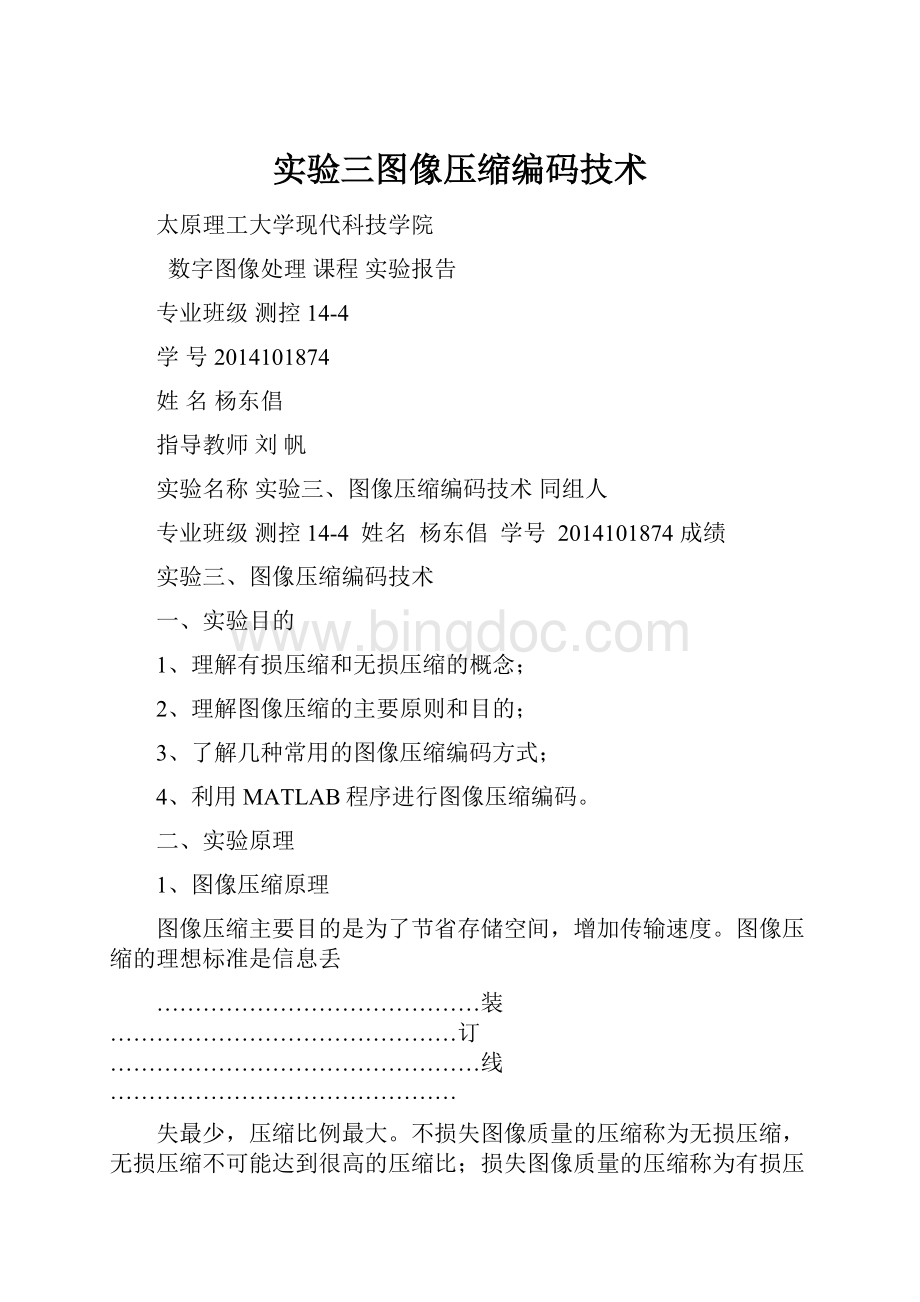实验三图像压缩编码技术Word文档下载推荐.docx
《实验三图像压缩编码技术Word文档下载推荐.docx》由会员分享,可在线阅读,更多相关《实验三图像压缩编码技术Word文档下载推荐.docx(16页珍藏版)》请在冰点文库上搜索。

损失图像质量的压缩称为有损压缩,高的压缩比是以牺牲图像质量为代价的。
压缩的实现方法是对图像重新进行编码,希望用更少的数据表示图像。
信息的冗余量有许多种,如空间冗余,时间冗余,结构冗余,知识冗余,视觉冗余等,数据压缩实质上是减少这些冗余量。
高效编码的主要方法是尽可能去除图像中的冗余成分,从而以最小的码元包含最大的图像信息。
编码压缩方法有许多种,从不同的角度出发有不同的分类方法,从信息论角度出发可分为两大类。
(1)冗余度压缩方法,也称无损压缩、信息保持编码或熵编码。
具体说就是解码图像和压缩编码前的图像严格相同,没有失真,从数学上讲是一种可逆运算。
(2)信息量压缩方法,也称有损压缩、失真度编码或烟压缩编码。
也就是说解码图像和原始图像是有差别的,允许有一定的失真。
应用在多媒体中的图像压缩编码方法,从压缩编码算法原理上可以分为以下3类:
(1)无损压缩编码种类
哈夫曼(Huffman)编码,算术编码,行程(RLE)编码,Lempelzev编码。
(2)有损压缩编码种类
预测编码,DPCM,运动补偿;
频率域方法:
正交变换编码(如DCT),子带编码;
空间域方法:
统计分块编码;
模型方法:
分形编码,模型基编码;
基于重要性:
滤波,子采样,比特分配,向量量化;
(3)混合编码。
有JBIG,H.261,JPEG,MPEG等技术标准。
本实验主要利用MATLAB程序进行赫夫曼(Huffman)编码和行程编码(RunLengthEncoding,RLE)。
三、实验内容
1、实现基本JPEG的压缩和编码分三个步骤:
(1)首先通过DCT变换去除数据冗余;
(2)使用量化表对DCT系数进行量化;
(3)对量化后的系数进行Huffman编码。
四、实验步骤
1打开计算机,启动MATLAB程序;
2选择一幅图像,并进行赫夫曼和行程编码压缩处理;
3将原图像在Photoshop软件中打开,分别以不同的位图文件格式进行“另保存”,比较它们的数据量。
4记录和整理实验报告
clear
loadwoman;
%X=imread('
girl.bmp'
'
bmp'
);
data=uint8(X);
[zipped,info]=huffencode(data);
unzipped=huffdecode(zipped,info,data);
subplot(121);
imshow(data);
subplot(122);
imshow(unzipped);
erms=compare(data(:
),unzipped(:
))
cr=info.ratio
whosdataunzippedzipped
function[zipped,info]=huffencode(vector)
if~isa(vector,'
uint8'
)
error('
inputargumentmustbeauint8vector'
end
[m,n]=size(vector);
vector=vector(:
)'
;
f=frequency(vector);
symbols=find(f~=0);
f=f(symbols);
[f,sortindex]=sort(f);
symbols=symbols(sortindex);
len=length(symbols);
symbols_index=num2cell(1:
len);
codeword_tmp=cell(len,1);
whilelength(f)>
1
index1=symbols_index{1};
index2=symbols_index{2};
codeword_tmp(index1)=addnode(codeword_tmp(index1),uint8(0));
codeword_tmp(index2)=addnode(codeword_tmp(index2),uint8
(1));
f=[sum(f(1:
2))f(3:
end)];
symbols_index=[{[index1,index2]}symbols_index(3:
symbols_index=symbols_index(sortindex);
codeword=cell(256,1);
codeword(symbols)=codeword_tmp;
len=0;
forindex=1:
length(vector)
len=len+length(codeword{double(vector(index))+1});
string=repmat(uint8(0),1,len);
pointer=1;
length(vector)
code=codeword{double(vector(index))+1};
len=length(code);
string(pointer+(0:
len-1))=code;
pointer=pointer+len;
len=length(string);
pad=8-mod(len,8);
ifpad>
string=[stringuint8(zeros(1,pad))];
codeword=codeword(symbols);
codelen=zeros(size(codeword));
weights=2.^(0:
23);
maxcodelen=0;
length(codeword)
len=length(codeword{index});
iflen>
maxcodelen
maxcodelen=len;
code=sum(weights(codeword{index}==1));
code=bitset(code,len+1);
codeword{index}=code;
codelen(index)=len;
codeword=[codeword{:
}];
cols=length(string)/8;
string=reshape(string,8,cols);
7);
zipped=uint8(weights*double(string));
huffcodes=sparse(1,1);
nnz(codeword)%length(codeword)%numel(codeword)
huffcodes(codeword(index),1)=symbols(index);
info.pad=pad;
info.huffcodes=huffcodes;
info.ratio=cols./length(vector);
info.length=length(vector);
info.maxcodelen=maxcodelen;
info.rows=m;
info.cols=n;
functionvector=huffdecode(zipped,info,image)
if~isa(zipped,'
len=length(zipped);
string=repmat(uint8(0),1,len.*8);
bitindex=1:
8;
len
string(bitindex+8.*(index-1))=uint8(bitget(zipped(index),bitindex));
string=logical(string(:
string((len-info.pad+1):
end)=[];
51);
vector=repmat(uint8(0),1,info.length);
vectorindex=1;
codeindex=1;
code=0;
code=bitset(code,codeindex,string(index));
codeindex=codeindex+1;
byte=decode(bitset(code,codeindex),info);
ifbyte>
vector(vectorindex)=byte-1;
vectorindex=vectorindex+1;
vector=reshape(vector,info.rows,info.cols);
functioncodeword_new=addnode(codeword_old,item)
codeword_new=cell(size(codeword_old));
length(codeword_old)
codeword_new{index}=[item
codeword_old{index}];
functionf=frequency(vector)
if~isa(vector,'
f=repmat(0,1,256);
len=length(vector);
forindex=0:
255
f(index+1)=sum(vector==uint8(index));
f=f./len;
functionbyte=decode(code,info)
byte=info.huffcodes(code);
functionerms=compare(f1,f2)
e=double(f1)-double(f2);
[m,n]=size(e);
erms=sqrt(sum(e(:
).^2)/(m*n));
iferms~=0
emax=max(abs(e(:
)));
[h,x]=hist(e(:
));
iflength(h)>
=1
figure(4)
bar(x,h,'
k'
e=mat2gray(e,[-emax,emax]);
figure(5);
imshow(e);
end
五、实验仪器
1计算机;
2MATLAB、Photoshop等程序;
3移动式存储器(软盘、U盘等)。
4记录用的笔、纸。
六、实验报告内容
1叙述实验过程;
2提交实验的原始图像和结果图像。
七、思考题
1.图像中哪些信息是主要的,哪些信息是次要的?
答;
频域的低频分量影响更大一些,而高频分量相对次要。
2.简述赫夫曼编码和行程编码的原理。
答:
赫夫曼编码:
先统计数据中各字符出现的概率,再按字符出现频率高低的顺序分别
赋以由短到长的代码,从而保证文件整体的大部分字符是由较短的编码所构成。
行程编码;
又称行程长度编码(Run
Length
Encoding,
RLE),
是一种熵编码,其编码原理是将具有相同值的连续串用其串长和一个代表值来代替,
该连续串就称为行程,串长称为行程长度。